
Stylophora pistillata, commonly known as hood coral or smooth cauliflower coral, is a species of stony coral in the family Pocilloporidae. It is native to the Indo-Pacific region and is commonly used in scientific investigations.

Diploastrea heliopora, commonly known as diploastrea brain coral or honeycomb coral among other vernacular names, is a species of hard coral in the family Diploastreidae. It is the only extant species in its genus. This species can form massive dome-shaped colonies of great size.

Paragoniastrea australensis, also known as the lesser star coral, is a species of stony corals in the family Merulinidae. It occurs in shallow water in the Indo-Pacific region.

Turbinaria stellulata, also known as disc coral, is a species of colonial stony coral in the family Dendrophylliidae. It is native to the Indo-Pacific region. The International Union for Conservation of Nature has rated its conservation status as being "vulnerable".

Turbinaria mesenterina, commonly known as disc coral, is a species of colonial stony coral in the family Dendrophylliidae. It is native to the Indo-Pacific region. The International Union for Conservation of Nature has rated its conservation status as being "vulnerable".

Turbinaria peltata, commonly known as disc coral, is a species of colonial stony coral in the family Dendrophylliidae. It is native to the Indo-Pacific region. The International Union for Conservation of Nature has rated its conservation status as being "vulnerable".

Favites pentagona is a species of stony coral in the family Merulinidae, sometimes known as larger star coral. It is native to the Indo-Pacific region and its range extends from the Red Sea through the Indian Ocean to the Western Pacific Ocean. This is a common species throughout its wide range and the International Union for Conservation of Nature has rated its conservation status as being of "least concern".
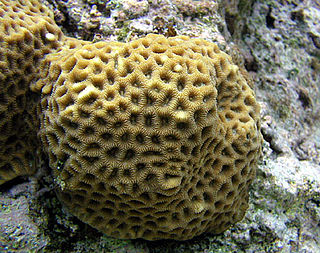
Favites abdita, also known as the larger star coral, is a species of stony coral in the family Merulinidae. It is native to the Indo-Pacific region and its range extends from East Africa and the Red Sea through the Indian Ocean to the Western Pacific Ocean. The International Union for Conservation of Nature has rated its conservation status as being "near-threatened".

Herpolitha is a monotypic genus of mushroom corals in the family Fungiidae. The only member of the genus is Herpolitha limax, commonly known as the tongue, slipper, mole or striate boomerang coral. It is a free-living species and is native to reefs and lagoons in the Indo-Pacific region. The International Union for Conservation of Nature has assessed this coral as being of "least concern".

Coelastrea aspera is a species of stony coral in the family Merulinidae. It is a colonial species native to the Indo-Pacific region where it occurs in shallow water. It was first described by the American zoologist Addison Emery Verrill in 1866 as Goniastrea aspera but it has since been determined that it should be in a different genus and its scientific name has been changed to Coelastrea aspera. This is a common species throughout much of its wide range and the International Union for Conservation of Nature has rated its conservation status as being of "least concern".

Favites complanata is a species of stony coral in the family Merulinidae, sometimes known as the larger star coral. It is native to the Indo-Pacific region and its range extends from the Red Sea and Indian Ocean to the western and central Pacific Ocean. This is an uncommon species of coral and seems to be decreasing in abundance, and the International Union for Conservation of Nature has rated its conservation status as being "near threatened".

Platygyra daedalea, sometimes known as the lesser valley coral, is a colonial species of stony coral in the family Merulinidae. It occurs on reefs in shallow water in the Indo-Pacific region. It is a common species and the International Union for Conservation of Nature has assessed its conservation status as being of "least concern".

Oulophyllia crispa, sometimes called the intermediate valley coral, is a species of stony coral in the family Merulinidae. It is native to the tropical western and central Indo-Pacific region. Although this coral has a wide range, it is generally uncommon and seems to be decreasing in abundance, and the International Union for Conservation of Nature has rated its conservation status as being "near threatened".

Blastomussa merleti, commonly known as pineapple coral, is a species of large polyp stony coral. It is unclear in which family the genus Blastomussa belongs. This coral is native to the west and central Indo-Pacific region and is sometimes used in reef aquaria.
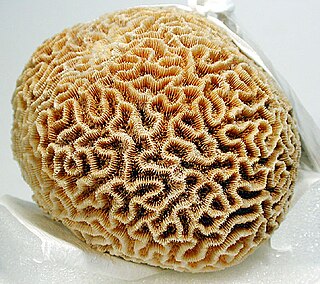
Goniastrea favulus, also known as the lesser star coral, is a species of stony coral in the family Merulinidae. It occurs in shallow water in the Indo-Pacific region. This is an uncommon species of coral and the International Union for Conservation of Nature has rated its conservation status as being "near threatened".
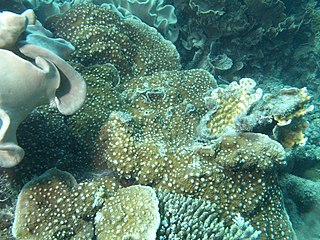
Oxypora lacera, the ragged chalice coral or porous lettuce coral, is a species of large polyp stony corals in the family Lobophylliidae. It is a colonial coral which can be submassive, encrusting or laminar. It is native to the western Indo-Pacific.
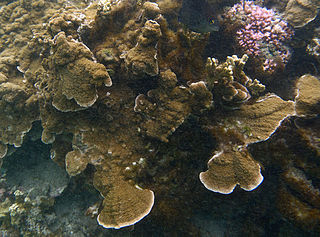
Echinophyllia aspera, commonly known as the chalice coral, is a species of large polyp stony corals in the family Lobophylliidae. It is a colonial coral which is partly encrusting and partly forms laminate plates or tiers. It is native to the western and central Indo-Pacific.

Dipsastraea pallida is a species of colonial stony coral in the family Merulinidae. It is found in tropical waters of the Indian and Pacific Oceans. This is a common species of coral with a widespread distribution, and the main threat it faces is from the destruction of its coral reef habitats. It is rated as a "least-concern species" by the International Union for Conservation of Nature. This species was first described in 1846 as Favia pallida by the American zoologist James Dwight Dana; it was later transferred to the genus Dipsastraea, but some authorities continue to use the original name.

Heterocyathus aequicostatus is a small species of coral in the family Caryophylliidae in the order Scleractinia, the stony corals. It is native to the Indo-Pacific region. It is a large polyp, solitary, free-living coral and is usually found on soft substrates.
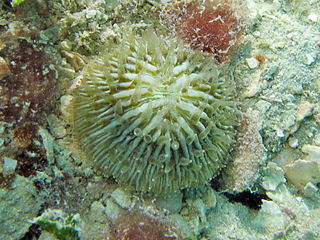
Cycloseris cyclolites is a species of disc coral in the family Fungiidae. It was first described by the French naturalist Jean-Baptiste Lamarck in 1815. It is native to the tropical and subtropical Indo-Pacific region where it is found on soft sediment in shallow water.






















